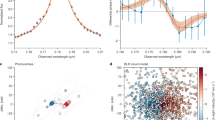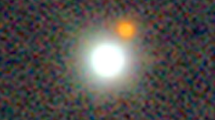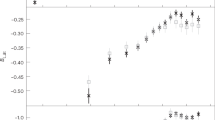Abstract
There are two main theoretical models for the central engine of quasars and other active galactic nuclei: the black hole model and the spinar model. Observations of the time scales of flux variations can rule out the black hole model and are therefore extremely important. The widely accepted argument of Elliot and Shapiro1 states that the maximal luminosity of the nucleus is given by the Eddington limit, LEdd = 1038 (M/M⊙) ergs−1, and the minimal time scale for periodicity is given by tmin = (gravitational radius)/(velocity of light) = 10−5 (M/M⊙) s. Therefore, the observed time scale of variations t, and the luminosity L must obey log t >log L −43. Variations on a time scale shorter than that would rule out the black hole model. We point out here that this statement is wrong in view of recent developments in the accretion disk theory: much shorter periodicities are still consistent with the black hole model.
This is a preview of subscription content, access via your institution
Access options
Subscribe to this journal
Receive 51 print issues and online access
$199.00 per year
only $3.90 per issue
Buy this article
- Purchase on Springer Link
- Instant access to full article PDF
Prices may be subject to local taxes which are calculated during checkout
Similar content being viewed by others
References
Elliot, J. L. & Shapiro, S. L. Astrophys. J. Lett. 192, L3 (1974).
Paczyński, B. & Wiita, P. J. Astr. Astrophys. 88, 23 (1980).
Jaroszyński, M., Abramowicz, M. A. & Paczyński, B. Acta Astr. 30, 1 (1980).
Abramowicz, M. A., Calvani, M. & Nobili, L. Astrophys. J. 242, 772 (1980).
Sikora, M. Mon. Not. R. astr. Soc. 196, 257 (1981).
Blandford, R. D. & Rees, M. J. in Pittsburg Conference on BL Lac Objects (ed. A. Wolfe) (Pittsburg University Press, 1978).
Orr, M. J. L. & Brown, I. W. A. Mon. Not. R. astr. Soc. 200, 1067 (1982).
Bardeen, J. M. in Black Holes (eds. DeWitt, B. & DeWitt, C.) (Gordon and Breach, New York, 1973).
Impey, C. D., Brand, P. W. J. L., Wolstencroft, R. D. & Williams, P. M. Mon. Not. R. astr. Soc. 200, 19 (1982).
Valtaoja, E. et al. Preprint (University of Turku, Turku-FTL-R 26, 1982).
Author information
Authors and Affiliations
Rights and permissions
About this article
Cite this article
Abramowicz, M., Nobili, L. Are there black holes in quasars?. Nature 300, 506–507 (1982). https://doi.org/10.1038/300506a0
Received:
Accepted:
Issue Date:
DOI: https://doi.org/10.1038/300506a0
This article is cited by
-
Optical monitoring and spectral analysis of the Seyfert galaxy NGC1275
Astrophysics and Space Science (2015)
-
Correlation between γ $\gamma$ -ray flux density and redshift for Fermi blazars
Astrophysics and Space Science (2015)
-
On the study of internal structure of superdense celestial bodies
Astrophysics (1992)
-
An introduction to the theory of internal structure of supermassive compact celestial bodies
Astrophysics and Space Science (1992)
-
Equilibrium configurations of protomatter. II
Astrophysics (1991)
Comments
By submitting a comment you agree to abide by our Terms and Community Guidelines. If you find something abusive or that does not comply with our terms or guidelines please flag it as inappropriate.



